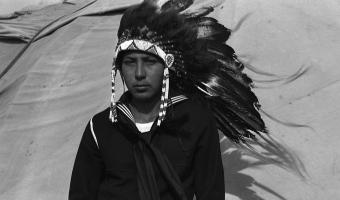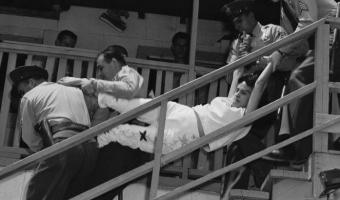Beyond the River: Free Zone-DMZ, The City that Lost the River
Glendale Library, Arts & Culture and ReflectSpace Gallery in cooperation with the City of Gimpo, South Korea and the Gimpo Cultural Foundation is proud to present “Beyond the River: Free Zone-DMZ, The City that Lost the River,” an exhibition that reflects on borders and divisions, specifically the far-reaching impact of the Demilitarized Zone (DMZ) between North and South Korea at the City of Gimpo.
The DMZ is a 2.5 mile wide swath that separates North and South Korea at around the 38th parallel. At its western edge is the estuary of the Han River where it flows into the waters of the Yellow Sea and where the City of Gimpo is situated. Even though the Armistice of 1953 designated the estuary as a “Neutral” or “Free” zone for commercial maritime travel, neither side has allowed this to happen. Gimpo, an ancient city with a history of maritime trade, has lost its river. In the exhibition, “Beyond the River: Free Zone-DMZ, The City that Lost the River,” several Korean artists reflect on this ephemeral and inaccessible border/river and consider how a city navigates the treacherous waters of partition.
The artists in the exhibition are: Han Ho, Lee Lee Nam, Lee Tae Soo, Kim Seung Woo & Cho Doo Young, Lee Ho Jin, and Floworks. “Beyond the River: Free Zone-DMZ, The City that Lost the River” is curated by Monica Hye Yeon Jun and Ara & Anahid Oshagan and runs December 21, 2020 - March 21, 2021.
“Beyond the River” is held simultaneously at the Gimpo Museum of Art in Gimpo, South Korea and ReflectSpace Gallery in Glendale. The exhibition is organized in cooperation with the City of Glendale and the City of Gimpo, the Gimpo Cultural Foundation, the Korean Foundation for International Cultural Exchange. The exhibition is part of a new cultural exchange program with the City of Gimpo, a sister city of Glendale.
Floworks by Lee Jae Hyung & Park Junk Min is a technology and artificial intelligence based work that continually streams information from the internet to create art. Here, the border, the DMZ, and Korean division is at issue and information is sourced from interviews and the internet to create digital faces that morph and change emotions as the information content ebbs and flows. The installation includes a searchlight projection, reminiscent of the militarized border that is continuously surveilled.
Han Ho reaches deep into history to create a massive work both spiritual as well as darkly human. Ho’s “The Last Supper of the 21st Century” replete with Jesus and full rank of the apostles, mimics the composition and texture of Da Vinci’s famed last supper painting but here Ho substitutes weapons of war for dining utensils. An edgy and unpredictable meal is taking place that could devolve into violence and destruction at any moment. This narrative of sudden conflict in mundane settings is all too real considering the military postures of the two Koreas.
Not unlike Han Ho’s work, Lee Tea Soo’s sculpture is delicately balanced between harmony and disaster. Perched on an untenably thin edge, a massive boulder seems to hover in mid-air above a meager steel stand. The boulder could topple at any moment. Where will it land? North or South? Either way, it will create massive waves of disruption.
A divided Korea is the very undercurrent of Moogy’s portraits of Korean war veterans. Witnesses to the inner mechanics of the division, these somber portraits are presented as halves, speaking to the impact of the divided Korean peninsula and raising the question: where is the other half of the portrait? Across the Han River, beyond the river, on the Northern side. But, of course, it could just as easily be viewed from the other side.
Lee Lee Nam deals with large universal themes of pain and healing through the often intense and jarring interaction between light and dark but also meditative and fluid movements of form. His immersive videos vacillate between these two extremes and incorporate histories of war and displacement.
Lee Ho Jin works in color and abstraction that represent geographic features, historical images and other data. The current series “Unlimited Thought” addresses borders and politically unstable times. The shapes and forms in his work echo disrupted rivers, seas and land and invite the audience to meditate on the geological features that unite and separate communities and countries.
All the works in “Beyond the River” underscore the symbiotic but fraught relationship between North and South Korea: a co-existence that is delicately balanced between everyday normalcy and the potential for sudden catastrophe. The artists strive to look beyond the river and to imagine new futurities for the Korean peninsula.
The DMZ is a 2.5 mile wide swath that separates North and South Korea at around the 38th parallel. At its western edge is the estuary of the Han River where it flows into the waters of the Yellow Sea and where the City of Gimpo is situated. Even though the Armistice of 1953 designated the estuary as a “Neutral” or “Free” zone for commercial maritime travel, neither side has allowed this to happen. Gimpo, an ancient city with a history of maritime trade, has lost its river. In the exhibition, “Beyond the River: Free Zone-DMZ, The City that Lost the River,” several Korean artists reflect on this ephemeral and inaccessible border/river and consider how a city navigates the treacherous waters of partition.
The artists in the exhibition are: Han Ho, Lee Lee Nam, Lee Tae Soo, Kim Seung Woo & Cho Doo Young, Lee Ho Jin, and Floworks. “Beyond the River: Free Zone-DMZ, The City that Lost the River” is curated by Monica Hye Yeon Jun and Ara & Anahid Oshagan and runs December 21, 2020 - March 21, 2021.
“Beyond the River” is held simultaneously at the Gimpo Museum of Art in Gimpo, South Korea and ReflectSpace Gallery in Glendale. The exhibition is organized in cooperation with the City of Glendale and the City of Gimpo, the Gimpo Cultural Foundation, the Korean Foundation for International Cultural Exchange. The exhibition is part of a new cultural exchange program with the City of Gimpo, a sister city of Glendale.
Floworks by Lee Jae Hyung & Park Junk Min is a technology and artificial intelligence based work that continually streams information from the internet to create art. Here, the border, the DMZ, and Korean division is at issue and information is sourced from interviews and the internet to create digital faces that morph and change emotions as the information content ebbs and flows. The installation includes a searchlight projection, reminiscent of the militarized border that is continuously surveilled.
Han Ho reaches deep into history to create a massive work both spiritual as well as darkly human. Ho’s “The Last Supper of the 21st Century” replete with Jesus and full rank of the apostles, mimics the composition and texture of Da Vinci’s famed last supper painting but here Ho substitutes weapons of war for dining utensils. An edgy and unpredictable meal is taking place that could devolve into violence and destruction at any moment. This narrative of sudden conflict in mundane settings is all too real considering the military postures of the two Koreas.
Not unlike Han Ho’s work, Lee Tea Soo’s sculpture is delicately balanced between harmony and disaster. Perched on an untenably thin edge, a massive boulder seems to hover in mid-air above a meager steel stand. The boulder could topple at any moment. Where will it land? North or South? Either way, it will create massive waves of disruption.
A divided Korea is the very undercurrent of Moogy’s portraits of Korean war veterans. Witnesses to the inner mechanics of the division, these somber portraits are presented as halves, speaking to the impact of the divided Korean peninsula and raising the question: where is the other half of the portrait? Across the Han River, beyond the river, on the Northern side. But, of course, it could just as easily be viewed from the other side.
Lee Lee Nam deals with large universal themes of pain and healing through the often intense and jarring interaction between light and dark but also meditative and fluid movements of form. His immersive videos vacillate between these two extremes and incorporate histories of war and displacement.
Lee Ho Jin works in color and abstraction that represent geographic features, historical images and other data. The current series “Unlimited Thought” addresses borders and politically unstable times. The shapes and forms in his work echo disrupted rivers, seas and land and invite the audience to meditate on the geological features that unite and separate communities and countries.
All the works in “Beyond the River” underscore the symbiotic but fraught relationship between North and South Korea: a co-existence that is delicately balanced between everyday normalcy and the potential for sudden catastrophe. The artists strive to look beyond the river and to imagine new futurities for the Korean peninsula.

